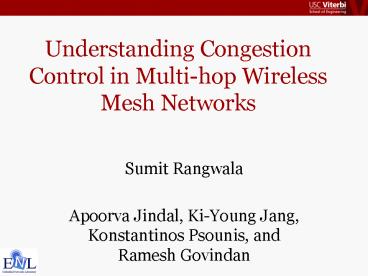Understanding Congestion Control in Multi-hop Wireless Mesh Networks - PowerPoint PPT Presentation
1 / 20
Title:
Understanding Congestion Control in Multi-hop Wireless Mesh Networks
Description:
Understanding Congestion Control in Multi-hop Wireless Mesh Networks. SumitRangwala. ApoorvaJindal, Ki ... TCP s performance on 802.11 mesh networks is known to be ... – PowerPoint PPT presentation
Number of Views:182
Avg rating:3.0/5.0
Title: Understanding Congestion Control in Multi-hop Wireless Mesh Networks
1
Understanding Congestion Control in Multi-hop
Wireless Mesh Networks
- Sumit Rangwala
- Apoorva Jindal, Ki-Young Jang, Konstantinos
Psounis, and Ramesh Govindan
2
Mesh Networks
- Static multi-hop mesh networks have been proposed
an alternative to wired connectivity - Users satisfaction hinges on transport
performance - TCPs performance on 802.11 mesh networks is
known to be poor - Starvation
Is poor transport performance inherent to
multi-hop mesh networks? Can a correctly
designed transport help make mesh networks a
viable alternative?
3
TCPs Performance
What mechanisms can help us achieve near-optimal
rates?
- TCP only signals flows traversing the congested
link - Link centric view of congestion
- Fails to account for neighborhood congestion
4
Approach
Neighborhood-centric Transport
WCP
WCPCap
5
Neighborhood of a Link
Link ? sender receiver pair
9
1
- Neighborhood of a link
- All incoming and outgoing links of
- Sender
- Receiver
- One hop neighbors of the sender
- One hop neighbors of the receiver
7
2
5
6
8
4
10
3
Prohibits channel capture at the sender or causes
collision at the receiver
Ensuing ACK prohibits channel capture at the
sender or causes collision at the receiver
Prohibits channel capture
Neighbors (overhearing)
6
WCP AIMD Based Design
Multiplicative Decrease
When a link is congested, signal all flows
traversing the neighborhood of a link to reduce
their rate by half, i.e., rf rf / 2 React to
congestion after RTTneighborhood
Key Insight Congestion is signaled to all flows
traversing neighborhood of a congested link
7
WCP
Additive Increase
During no congestion increase a flows rate as
rf rf a Every RTTneighborhood
RTTneighborhood Largest flow RTT within the
neighborhood
Key Insight Rate adaptation is clocked at the
largest flow RTT in a neighborhood
8
Simulations Stack Topology
- Simulation setup
- Qualnet 3.9.5
- 802.11b MAC with default parameters
- TCP SACK
- Auto rate adaptation is off
1
3
2
4
5
6
8
7
9
- WCP achieves near optimal performance
- Through congestion sharing in the neighborhood
9
Approach
Neighborhood-centric Transport
WCP
WCPCap
10
WCPCap Explicit Rate Feedback
- Estimate residual capacity in a neighborhood
- Need to know the achievable rate region for
802.11-scheduled mesh networks - Using only local information
Challenge Is a given set of rates achievable in
a neighborhood?
11
Calculating Achievable Rates
Check feasibility, i.e., for each link,
Packet arrival rate Eservice time of a packet
U, 0 U 1
Compute expected packet service time for a link
from collision and idle probability of the link
Decompose the neighborhood topology of a link
into canonical two-link topologies
Find collision and idle time probability of the
link in every two-link topology
Combine, incorporating local link dependencies,
individual probabilities to find net collision
and idle probabilities for the link
Combine, incorporating link dependencies,
individual probabilities to find net collision
and idle probabilities of the link
Requires global information
Using only local information
Jindal et. al., The Achievable Rate Region of
802.11 Scheduled Multi-hop Networks.
12
WCPCap Explicit Rate Feedback
- Every epoch
- Find, by binary search, the largest increment or
smallest decrement, d, such that the new rates
are achievable yet fair - Increase/decrease rate of each flow by d
U1 (100 utilization) would yield large delays,
we target U0.7
13
Simulations Stack Topology
- Simulation setup
- Qualnet 3.9.5
- 802.11b MAC with default parameters
- TCP SACK
- Auto rate adaptation is off
- WCPCap slightly better than WCP
- Yields smaller queue and thus smaller delays
- Not as good as optimal as we target 70
utilization
14
Simulations Diamond Topology
1
3
2
4
5
6
8
7
9
- WCP does not achieve max-min rates
- Rates are dependent on the number of congested
neighborhood and the degree of congestion - WCPCap achieves max-min rates
15
Experimental Setup
- Mini-PCs running Click and Linux 2.6.20
- ICOP eBox-3854
- 802.11b wireless cards running the madwifi driver
- Omni directional antennas
- some antennas covered with aluminum foils to
reduce transmission range
16
Experimental Results Stack Topology
Simulations
Experiments
For this topology, WCPs simulation and
experimental results are nearly identical
17
Experimental Results Arbitrary Topology
18
18
23
23
10
10
24
24
16
16
22
22
12
12
26
13
26
13
15
15
19
19
11
11
20
20
14
14
- 14 nodes and five flows
- TCP starves different flows during different runs
WCP consistently gives fair rates
18
Related Work
- WCP
- Congestion control schemes explicitly recognizing
neighborhood - NRED, EWCCP, and IFRC
- Congestion control for ad-hoc wireless networks
- TCP-F, TCP-ELFN, TCP-BuS, ATCP, etc.
- COPAS, LRED, ATP, etc.
- Congestion control for last-hop wireless networks
- I-TCP, Snoop, WTCP, etc.
- WCPCap
- Heuristic based capacity estimation
- WXCP and XCP-b
- Schemes that also change the MAC layer
- e.g, wGDP, DiffQ
19
Conclusions and Future Work
- Demonstrate plausibility of distributed fair rate
control for mesh networks - Low overhead AIMD scheme
- Explicit rate feedback scheme
- Future Work
- Optimizing AIMD parameters in WCP
- Reduce control overhead of WCPCap
- More extensive experiments
20
Thank You































